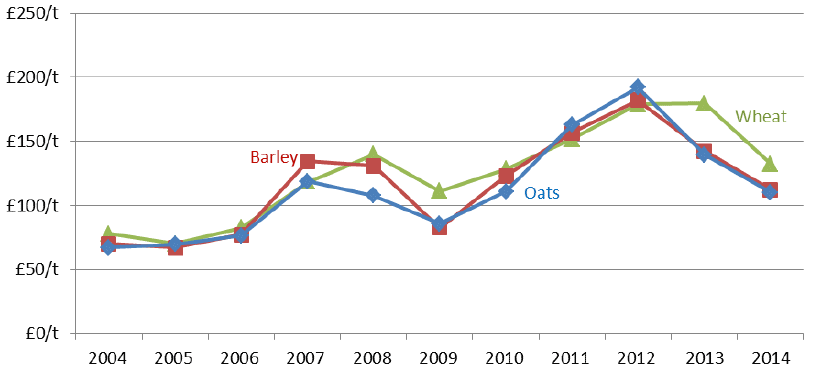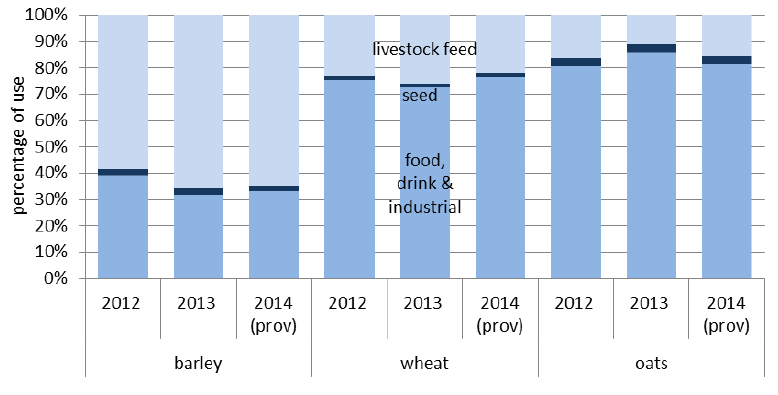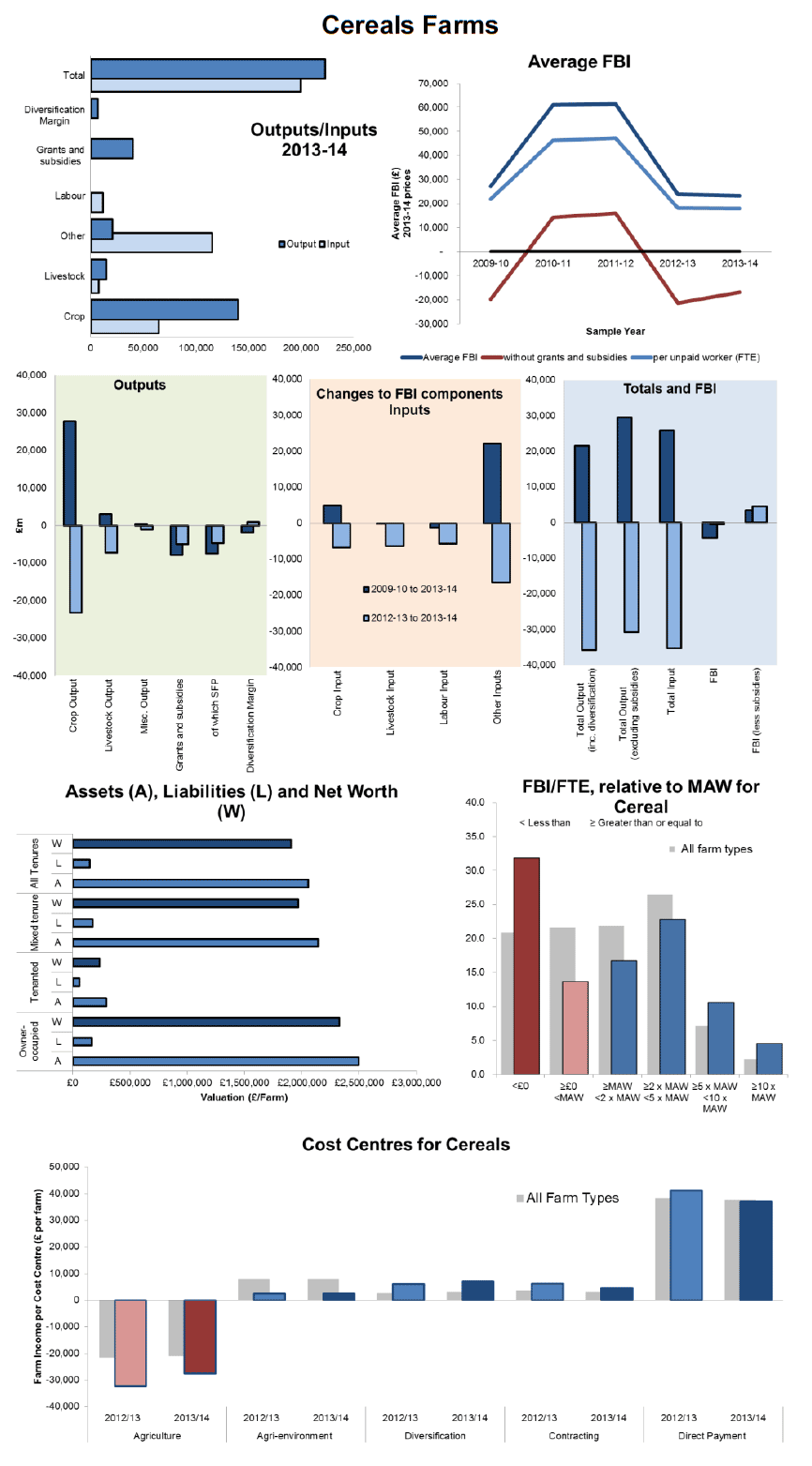Economic Report on Scottish Agriculture 2015
Economic Report on Scottish Agriculture 2015 presenting an overall picture of Scottish agriculture using data from the various agricultural surveys that RESAS manage.
4.2 Cereals
4.2.1 Income from cereals (Table A3)
Cereals account for about 12 per cent of total farm output, an estimated £381 million in 2014 and around 45 per cent of the output from crops in general.
Chart 4.5 shows trends in the average annual output prices for cereals, used in the TIFF valuation. It is important to note that these calendar year prices span two crop production years and represent the value of cereals when they are used or sold off the farm. They also represent an average across different types of cereals used for animal feed, seed, human consumption and industrial purposes. These prices, which are obtained from the HGCA (Home Grown Cereals Authority) incorporate tonnages sold on forward contracts as well as cereals sold at spot prices.
Cereal output prices were relatively stable between 2004 and 2006, before increasing substantially in 2007 and remaining high in 2008. They then dropped quite markedly in 2009 before three years of increases. After peaking in 2012 at £180 to £190 per tonne, prices have fallen to about £110 (barley and oats) or £130 (wheat) per tonne, reflecting global trends in supply and demand of cereals.
Chart 4.5: Annual average output prices for cereals 2004 to 2014

Chart 4.6 shows the utilisation of cereals for different purposes. In 2014, the majority of barley (65 per cent) was used for animal feed, whilst the majority of wheat (76 per cent) and oats (81 per cent) was used for human and industrial purposes.
Chart 4.6: Cereal utilisation: 2012 to 2014

In 2014, total value of cereal output fell by 46 million (down 11 per cent), compared to 2013, following a previous decrease of £23 million (five per cent) between 2012 and 2013. The output value of barley fell by £52 million (down 18 per cent), due to a £31 per tonne (22 per cent) decrease in price outweighing a 82,000 tonne (four per cent) increase in production. The output value of wheat rose by £15 million (13 per cent), due to a 336,000 tonne (52 per cent) increase in production, despite a £47 per tonne (26 per cent) decrease in price. The value of oats decreased by £9 million (34 per cent), driven by a 34,000 tonne (18 per cent) decrease in production and £29 per tonne (21 per cent) decrease in price.
4.2.2 Cereal farms FBI (Table B1)
Accounting for inflation, between 2009-10 and 2013-14 the average FBI of cereal farms decreased by around 16 per cent. This was due to an increase in input costs for crops and land and buildings.
In the last year both input and output values for cereal farms have decreased, this combined with an average decrease in the value of grants and subsidies (down £5,000) resulting in an overall decrease in income for 2013-14 to leave the FBI value of cereal farms at £23,000. The total average outputs, (including income from diversification and grants and subsidies) and inputs for cereal farms were £223,000 and £200,000 respectively. The largest portion of the input costs was due to other inputs such as machinery, land and buildings.
Over the last five years, FBI without subsidies has been below zero three times, ranging from -£21,000 in 2012-13 to £16,000 in 2011-12. In 2013-14 the average FBI without subsidies of cereal farms was -£17,000.
The average FBI/FTE for cereal farms of £18,000 is roughly equivalent to an hourly wage for unpaid labour of £9.42, almost equivalent to one and a half times the minimum agricultural wage in Scotland (£6.89). Approximately 38 per cent of farms
Cereals Farms

generated an FBI/FTE equivalent to at least twice the minimum agricultural wage per hour of unpaid labour. At the top end, 11 per cent generated between five and ten times the minimum agricultural wage, that is, between £33.40 and £68.90 per hour of unpaid labour and five per cent generated more. In contrast, the income of nearly half of all cereal farms (46 per cent) equated to less than the minimum agricultural wage, per unit of unpaid labour.
Cost centre analysis (see section 3.8) for cereal farms show a slight overall decrease in income as part of environmental activities, contracting and subsidies compared to 2012-13. Income from agricultural and diversified activities improved in 2013-14.
The average net worth of cereal farms of all tenures was £1,906,000; from £234,000 for tenanted farms, to £1,968,000 for mixed tenure farms and £2,328,000 for owner occupied farms. The average debt ratio (liabilities: assets) was seven per cent for all tenures of cereals farms but ranged between seven per cent for owner-occupied and 21 per cent for tenanted farms.
Contact
Email: Agricultural Statistics
There is a problem
Thanks for your feedback